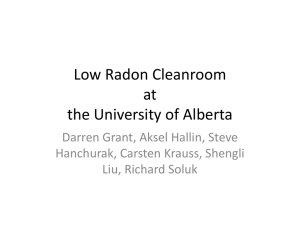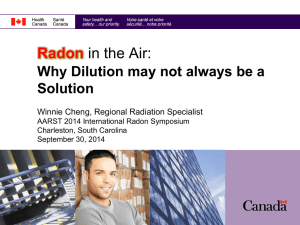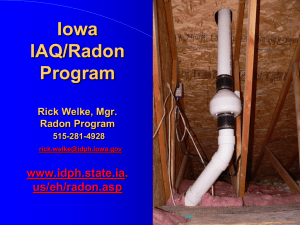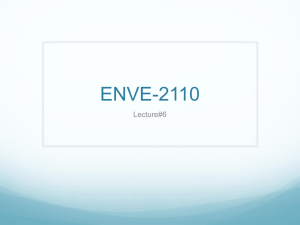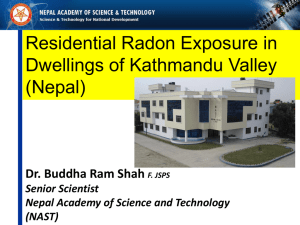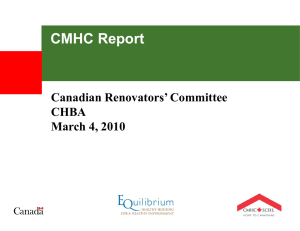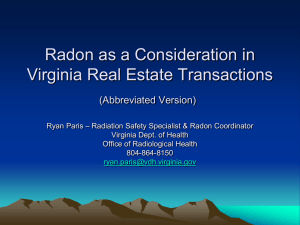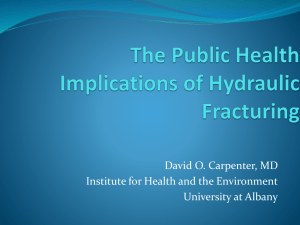Health Canada Presentation
advertisement
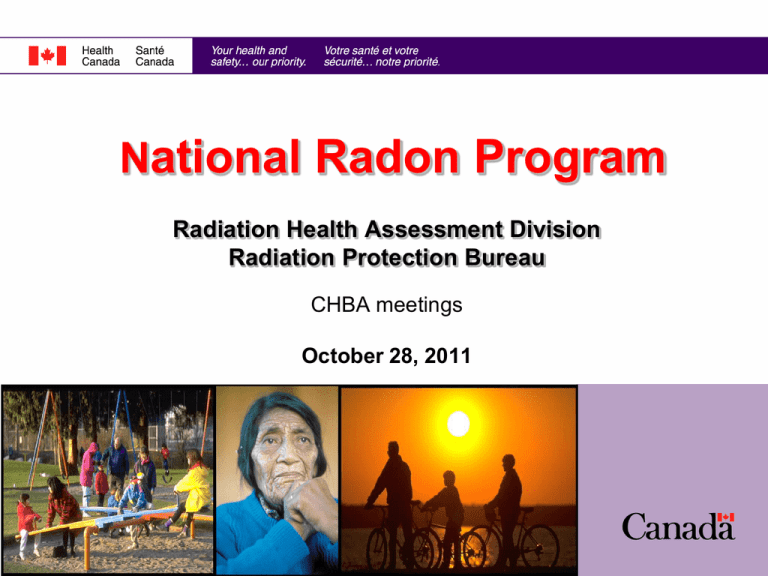
National Radon Program Radiation Health Assessment Division Radiation Protection Bureau CHBA meetings October 28, 2011 RADON KEY MESSAGES • If the radon level is found to be high, it can be fixed easily and at a reasonable cost • Radon is a radioactive gas that is produced naturally by the breakdown of uranium in the ground and can get into your home undetected. You can’t see it, smell it or taste it • Long-term exposure, especially for smokers, to elevated levels of radon in the home increases your risk of developing lung cancer • The only way to know the radon level in your home is to take a simple and inexpensive test. Long-term testing for a minimum of 3 months is recommended. Health Canada is encouraging all Canadians to test their homes for radon National Radon Laboratory 1. NATIONAL RADON LABORATORY • Equipped with a variety of detection equipment (E-Perm, alpha track, continuous radon monitors) • Provides radon analyses for testing projects and research support • Provides technical expertise and advice for radon measurement • National Building Code • Certification of Measurement and Mitigation Professionals National Radon Laboratory • Launched Federal Building Testing Program – over 8000 buildings tested to date: 5.5% of results above the guideline • Launched cross Canada residential radon testing project – ~14,000 homes tested – 93% (112 of 121) of the Health Regions that participated had homes that tested above the Canadian guideline – ~ 7% of Canadian homes exceed the guideline level • New 2010 National Building Codes for protection against radon • Development of a Canadian Certification Program Cross-Canada Residential Radon Survey Year 1 Results Population Weighted % Homes >200 Bq/m3 AB 6.9% BC 4.6% MB 23.5% NB NU 0.0% ON 4.9% PE 4.5% QC 9.0% 17.0% NL 5.3% NS 8.2% SK 15.8% NT 4.0% YT 15.9% Year 2 – Data analysis is in progress, results appear similar Data analysis and report/papers will be written this fall/winter, to be published when approved Mitigation Guide-Highlights The guide has been written for professional contractors and includes: • An Overview of Radon • Confirming the Radon Test was Carried Out Properly • An Overview of Radon Reduction Systems • • • • Ventilation Methods and Sealing Exposed Soil. Sub-Slab Depressurisation Sump and Drainage System Depressurization Fan and pipe installation Building codes and radon mitigation Post installation testing Safety precautions Where Does Radon Come From? How Does Radon Enter Houses? The rate at which soil gas enters a building depends on: • resistance of the soil to gas movement- soil type and structure, soil moisture, and freezing • foundation design and construction • the pressure differences between the house and the soil. The radon supply rate (Bq/h) depends on the soil gas entry rate and the radon concentration in the soil gas. This is typically 40 to 80 kBq/m3, so a flow of 1 m3/hour can produce concentrations of >200 Bq/m3 in a house. Entry Routes Poured Concrete Basement Block Walls Mitigation Methods The radon concentration in living spaces can be reduced by: • increasing the ventilation rate in the living space or adjacent spaces to dilute the radon as it enters. • changing the internal air circulation patterns to intercept air containing radon before it enters the living space, and diverting it to the outdoors. • by decreasing the flow of soil gas into the house through the foundation. This can be done by: -closing openings through the foundation to the soil; -decreasing the pressure in the soil beneath the building or beneath a membrane so that soil gas no longer flows from the soil into the building. [Active Sub-Slab Depressurization (ASD) and variationscrawl space, block wall, tile drain/sump] Mitigation Steps 1- Confirm the initial radon test(s) were carried out properly 2- Investigate the house to decide what mitigation system is needed 3- Determine feasibility of proposed system and design (“diagnostics”) 4- Installation 5- Post-mitigation measurement. Designing a SSD System Canadian Certification Program History • Implementation of the new radon guideline and increased public awareness of the risks from radon exposure created a need to develop nationally recognised standards for knowledge and proficiency assessment of radon measurement and mitigation services and products in Canada. • Health Canada considered two options for development of a Certification program-a government operated program or a program operated by private industry with guidance from the federal government. Based on cost and time needed for a federally operated program, the second option was pursued. • NEHA-NRPP’s existing program has a good infrastructure already in place - Canadian certification will differ where required Canadian Certification Program Status • Agreement between NEHA,AARST& Health Canada has been formalised • All parties working to finalize all of the components required to launch the new Canadian NEHA-NRPP program • Health Canada’s role in this process - provide support and guidance in the development of the training curriculum and Canadian certification exams to ensure both are in accordance with Canadian guidance and protocols. Expected to launch in early spring 2012 Canadian Certification Program - Structure 5 Components of the Program Three Individual Certifications Three Individual Certifications Lab. Accreditation Lab. Accreditation Device Evaluation /Approval Device Evaluation/Approval Continuing Education Continuing Education Approval Chamber Protocols Chamber Protocols Canadian Certification Program Role of Health Canada • Collaboration with the U.S certification body, NEHA-NRPP to establish Canadian component of the program • Training curriculum development and Canadian specific exams for measurement and mitigation to ensure accordance with Health Canada's radon guideline and protocols • Responsible for translation of program materials into French • Assist NEHA-NRPP with competency assessment of radon measurement professionals by providing QA/QC oversight Canadian certification will not be administered by Health Canada -NEHA-NRPP will act as the credentialing body, providing all program management services in accordance with their Program procedures Canadian Certification Program Key features of the Canadian Certification Program • Differences in the measurement units : Bq/m3 vs. pCi/L • Long term testing recommended • Competency assessment of Measurement professionals through a QA/QC Program • New Bilingual Canadian Exams for Measurement and Mitigation • Not tied to real estate transactions • Differences based on Canadian geology and climate • Distance Learning will be important as well-CERTI In Canada - Currently 70+ measurement and 40+ mitigation professionals NEHA-NRPP certified • We need more course providers in Canada-possible partners include HRAI, ACCC, and Climate Care Radon Education and Awareness Performance Indicators Progress to date Increased radon awareness 20+ stakeholder engagements /yr 50+% increase in web traffic 100% + increase in inquiries/yr National outreach campaigns – social media and traditional # information products developed 9 products developed since 2008 **350,000+ brochures distributed Radon Measurement and Mitigation availability Test kit availability in Canadian national home improvement stores & NGOs Significant increase in certified radon measurement and mitigation professionals (70+ & 40+) Newest Radon outreach product Radon Education and Awareness E&A Goals and indicators Progress to date National Radon Outreach Campaign Environmental Health campaign launched in March 2010 CLA national social media campaign National outreach to health professionals Radon pro-active media campaign in fall / winter Provincial focused outreach in fall /winter across Canada Stakeholder engagement and partnership Strong partnerships with NGOs – CLA, CCS, CMA and CHBA and Radon service industry Improved engagement with OGDs and provinces, municipalities 2011 and Beyond – Next Steps 2011 and Beyond – Next Steps National Radon Laboratory • Collaborate with stakeholders and partners to encourage the adoption of the revised building codes across the country • Successful launch and implementation of the Canadian certification program Radon Test Projects • Completion of the federal building testing project in 2012/13 Radon Mapping • Work with provinces to provide modeling concept and encourage development of provincial mapping 2011 and Beyond – Next Steps Radon Research 2011 and Beyond – Next Steps • Complete research project on large building radon remediation and develop guidance documents • Compare ground level and roof level discharge • Investigate at on-demand ventilation fans for ASD • Would like to collaborate with CHBA to build some new homes incorporating the 2010 NBC changes soon Education and Awareness • Continue to build on activities that have been most successful with partners – CLA, CMA, CCS, CHBA • Target activities to those most at risk • Focused activities around NBC revisions and Canadian Certification program • Homeowner outreach via Canada Post’s Smartmoves program
